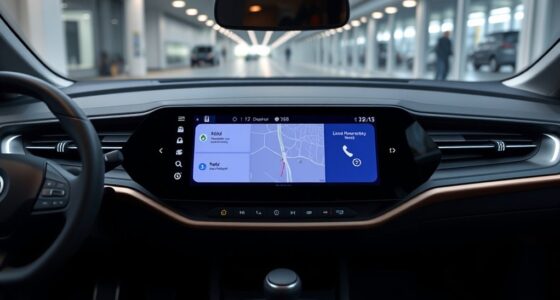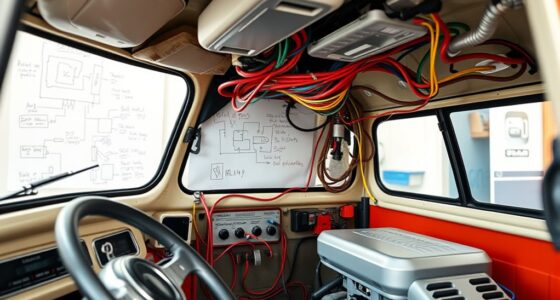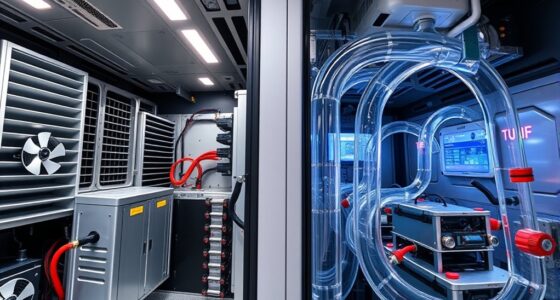Understanding how electric buses distribute weight is essential for safety and performance. By strategically positioning batteries near the center, you guarantee balanced axle loads, improving handling and reducing tire wear. Proper weight distribution enhances stability, minimizes suspension strain, and lowers safety risks during sharp turns or sudden stops. If you want to learn more about optimizing battery placement for better bus performance and longevity, keep exploring how weight management impacts electric bus efficiency.
Key Takeaways
- Central battery placement ensures balanced axle load and improved vehicle handling.
- Even weight distribution reduces stress on suspension components and tire wear.
- Proper load balance enhances bus stability, safety, and maneuverability during operation.
- Strategic battery positioning optimizes energy efficiency and extends vehicle lifespan.
- Uneven weight distribution can lead to safety risks and increased maintenance costs.

Electric buses are transforming public transportation, but their weight distribution plays a critical role in their performance and safety. One of the key factors influencing this is battery placement. Unlike traditional diesel buses, electric models rely heavily on large batteries that can be quite heavy. Where you position these batteries impacts how the weight spreads across the vehicle. If you place the batteries centrally, near the middle of the bus, it helps maintain a balanced axle load distribution. This central placement ensures that neither the front nor the rear axle bears too much weight, which is essential for handling, braking, and overall stability. Conversely, situating batteries at the rear or front can lead to uneven axles’ load, increasing wear on suspension components and raising safety concerns during sharp turns or sudden stops.
You also need to pay attention to axle load distribution, which directly affects how the bus performs on the road. Proper distribution means the weight is evenly spread across all axles, preventing excessive strain on any single point. If the load is front-heavy due to battery placement, the front axle may carry more weight, impacting steering and braking efficiency. On the other hand, rear-heavy configurations can make the rear axle prone to overloading, affecting ride comfort and increasing tire wear. Achieving the essential axle load distribution involves carefully planning where you position the batteries and how the rest of the bus’s weight is managed. For example, distributing batteries evenly or placing them slightly lower can help lower the center of gravity, enhancing stability and reducing the risk of rollover, especially at higher speeds or during sharp maneuvers. Additionally, understanding weight distribution is vital for optimizing the bus’s overall energy efficiency and longevity.
Balancing the weight across axles isn’t just about safety; it also influences the bus’s energy efficiency and maintenance costs. An uneven load causes uneven tire wear and can strain the suspension system, leading to more frequent repairs. Proper battery placement and axle load distribution are fundamental for maximizing the electric bus’s lifespan and performance. When you understand and optimize these aspects, you guarantee a smoother ride, better handling, and safer operation. This requires a strategic approach during design and regular checks during operation to keep the weight distribution in check as the batteries age and the bus’s load varies. Ultimately, your attention to battery placement and axle load distribution will determine how well the electric bus performs in real-world conditions, making transportation safer, more efficient, and more sustainable.
Frequently Asked Questions
How Does Weight Distribution Affect Passenger Comfort in Electric Buses?
Weight distribution directly affects passenger comfort in electric buses by influencing ride smoothness and stability. When weight is balanced, passenger seating remains steady, reducing jarring movements. Properly distributed weight also allows for wider aisles, giving you more space to move comfortably. If the weight isn’t well balanced, you might experience a bumpier ride and cramped aisles, making your journey less comfortable.
What Are the Best Practices for Maintaining Optimal Weight Balance?
Think of your electric bus as a tightrope walker balancing a pole. To keep it steady, you should practice cargo management and load enhancement, ensuring weight is evenly distributed. Regularly check and adjust the cargo placement, avoid overloading specific areas, and prioritize balanced loading. This proactive approach maintains ideal weight balance, enhances safety, and prolongs vehicle lifespan, helping your bus perform smoothly and reliably on every journey.
How Does Weight Distribution Influence Bus Maintenance and Longevity?
Weight distribution directly affects bus maintenance and longevity by impacting chassis stabilization and axle alignment. When weight isn’t balanced properly, you risk uneven tire wear, increased stress on suspension components, and potential chassis damage. Regularly checking and adjusting axle alignment helps guarantee even load distribution, reducing wear and tear. Proper weight management maintains ideal chassis stability, extends component life, and minimizes costly repairs, keeping your electric bus running smoothly longer.
Are There Differences in Weight Distribution Between Various Electric Bus Models?
Yes, different electric bus models have varying weight distributions due to battery placement and chassis design. Some prioritize placing batteries low and centrally for better balance, while others might position batteries differently based on chassis layout. These design choices impact weight distribution, affecting handling and stability. As a result, you’ll notice differences across models, influencing maintenance needs and overall performance.
How Does Weight Impact the Regenerative Braking Efficiency?
You’ll find that a bus weighing over 12 tons can generate up to 30% more regenerative energy during braking. Weight directly boosts braking efficiency because heavier vehicles transfer more kinetic energy into the system. When you brake, this regenerative energy is captured and stored, making your bus more efficient. So, a well-balanced weight distribution maximizes regenerative braking, helping save energy and extend the bus’s range.
Conclusion
By understanding the weight distribution of electric buses, you can see how it influences their performance and safety. Proper balance is like the keystone of an arch, holding everything firmly in place. When you optimize weight distribution, you improve handling, extend battery life, and ensure passenger comfort. So, think of it as fine-tuning a musical instrument—you’ll get a smoother, more harmonious ride, making electric buses a reliable and efficient choice for the road ahead.









